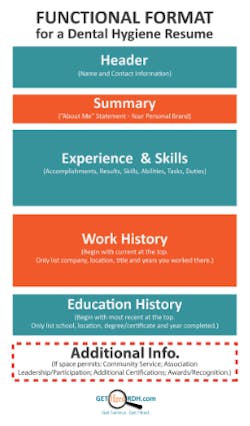GetHiredRDH: A dental hygiene resume format employers will love
By Doug and Tracie Perry
OK, I get it, dental hygiene resume formatting is boring stuff, right? It may not be the most interesting topic, but there’s an art to creating a resume for clinical jobs that will get interviews.
If your approach has been simply to use a generic template from a Google search, you might be costing yourself several great interview opportunities and job offers. That’s not an exaggeration. Dental employers, particularly small practice owners, are looking for someone special. With lots of applicants in a saturated market, they have plenty of options and want to see something different from applicants right from the start.
That’s where your dental hygiene resume comes in.
There are lots of ways to stand out with a resume. I won’t get into many of them here because I want to focus on the most important one first. If you have questions or want more information, you can visit my website at gethiredrdh.com to get many other secrets on resume writing.
The best dental hygiene resume format
There are three generally-accepted formats for resumes in the US and Canada, and other countries as well. The first two are the reverse-chronological style and the functional style. The third is a sort of a hybrid of the first two called the combination style.
The reverse-chronological style is the most popular because it enables applicants to focus their key selling points and qualifications on what they did for each job they’ve held. That’s important because each position, even within the same industry, can come with vastly different accomplishments and experiences. However, clinical dental hygiene positions are usually very similar. As such, if much of your career has been spent in a clinical setting and you’re seeking a new clinical job, it might be difficult to create a unique set of accomplishments and duties for each job.
Why is the functional style best?
First, the similarity in positions avoids repetition in your content (accomplishments and skills). This enhances the readability of the document, which plays into my next two points. Second, what you lose in redundancy you gain in extra space. What you do with that space depends on you, however, I would encourage you to use it to create a more attractive document instead of cramming it with more content.
My third point is the bottom line to the functional style resume. This extra space means you can create a resume that is far more readable for employers. A clean and simple document is much easier for someone to pick up and efficiently navigate visually.
Studies show that employers spend less than 10 seconds reviewing each resume for a job opening, so that simplicity and visual appeal is not only important, it can logically extend that 10-second average into 20 or 30 seconds because you’ve given the employer something different and special … like you!
How to create a functional style resume
By now you may be wondering how to get started on creating a functional resume. I’m glad you asked.
The functional resume begins the same way others do, with a header and summary sections in the top one-fourth of the document. Next, display your current skills and accomplishments in a section by itself. This is the key departure from the reverse-chronological style, which has you list each job you’ve had and beneath each job list the skills and accomplishments unique to each.
The skills and accomplishments section should be a bullet list of the main things you’ve accomplished in your career or things you know how to do. But rather than just list that you know how to do them, use positive verbs that allow each bullet to jump into how well you know how to do things. There is a list of more than 500 of these on my website.
For example, instead of saying you follow protocols of infection control, say you are “Diligent in following protocols of infection control.” These kinds of statements highlight your ability to excel at traditional job duties. Create a brief marketing statement for each of your skills and accomplishments to make it more influential and interesting.
After that section, which should take up about 30% to 40% of the space on your resume, it’s time to list the jobs you’ve held. Keep it simple, just name of the job, location, your title, and the length of time you were there. Next, and possibly last depending on how much space you have left, include your education. You should keep this succinct with name of school, location, degree earned, and year finished.
If you still have room, include specifics on licensure and certifications, dental-related community service, awards or honors, and so on. But use the space wisely, don’t add things just for the sake of adding them. Remember, the visual appeal matters to the person reading and will make a difference in getting you interviews.
That’s pretty much it. Functional-style resumes are not a one-size-fits-all approach to dental hygiene resume writing. I’ve used other styles that are equally as effective at marketing hygienists for job openings. But I think you will find that for most hygienists seeking a clinical job, this does the trick better than any others.
What not to include in a resume
Just to be clear, there are certain things you want to leave out of your dental hygiene resume. These include extra phone numbers, your mailing address, hobbies, birthday, social security number, marital status, information about children, or anything that even hints at race, religion, or politics.
Doug and Tracie Perry are coauthors of the e-book “Landing a Great Dental Hygiene Job.” Together they own GetHiredRDH.com, a career website for dental hygienists. Doug writes new tips each week and offers his dental job marketing expertise. The website includes one-on-one coaching, resume writing, and other related services.

